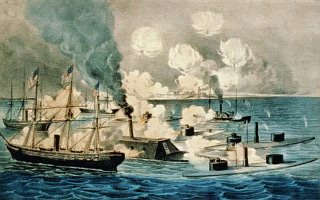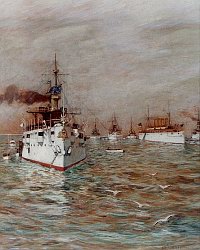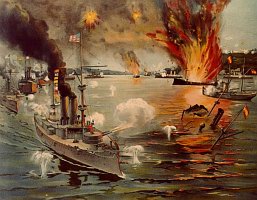The United States Navy
.
The US Navy in the Civil War
and After
.
The American Civil War of 1861 – 1865 threatened
the very survival of the nation and imposed a crucial wartime task on the
United States Navy. The Navy, also known during the war as the Union Navy,
was ordered to blockade the entire Southern coastline to prevent Confederate
cotton export or receipt of munitions and trade goods. To accomplish this
goal, the Navy expanded from 42 to 670 ships and seized major Southern
seaports from Virginia to Texas.
.

Lithograph commemorating the
1864 Union victory
at Mobile Bay in the greatest
naval battle of the Civil War.
|
.,.v |
One very hard-fought battle occurred in August
1864, when Rear Admiral David Farragut forced his way past Confederate
forts to take Mobile Bay, Alabama.
As enemy resistance stiffened, Admiral Farragut
led his ships with the valiant words, "Damn the torpedoes! Full steam ahead!" |
.
The Navy fought several dangerous rebel commerce
raiders and blockade-runners throughout this blockade. Military engagements
occurred between Confederate raiders, monitors and even primitive submarines.
.
| The 1862 duel between the Confederate ironclad
C.S.S. Virginia (ex Merrimack) and the Union ironclad Monitor
at Hampton Roads, Virginia, marked the first contest between warships without
sails and covered in iron. |
..... |
 The USS Monitor (foreground)
battles the CSS Virginia
The USS Monitor (foreground)
battles the CSS Virginia
|
.
Furthermore, the Navy also launched riverine
forces along major waterways that assisted the Army’s offensive operations
Bombardments of enemy forts and amphibious
operations to liberate enslaved regions also punctuated this prolonged
and difficult, but ultimately successful, Navy blockade.
.
 The U.S. North Atlantic
Squadron
The U.S. North Atlantic
Squadron
anchored in Hampton Roads,
Virginia, in 1898.
|
........ |
Following the Civil War, the Navy embarked
on a naval revolution that slowly transformed the old sailing fleet into
armored steam squadrons. These squadrons were rearmed with rifled guns
and refitted with other major technical advances.
The long period of peace relegated the new
warships to patrol duties and international cruises to shield growing American
sea commerce by showing the flag in foreign ports. However, many obsolete
ships remained in service because of paltry funding for newer designs.
Steel warships of advanced construction were not authorized until 1883,
which marked the beginning of the “modern Navy”. |
.
| The modern and well-trained Navy won resounding
victories over obsolete European adversaries during the Spanish-American
war of 1898.
On May 1, an American naval squadron entered
Manila Bay within the Philippines and defeated the ten defending Spanish
warships. On July 3, another American naval armada gained complete victory
over the Spanish fleet off Cuba |
....... |
 Battle of Manila Bay:USS
Olympia in the left
Battle of Manila Bay:USS
Olympia in the left
foreground, leading the U.S. Asiatic
Squadron
in destroying the Spanish fleet
off Cavite.
|
.
.
.
[ I. Development ]..[
II. Facts about the WAVES ]..[
III. Uniforms ]..[
IV. Sources ]
|
